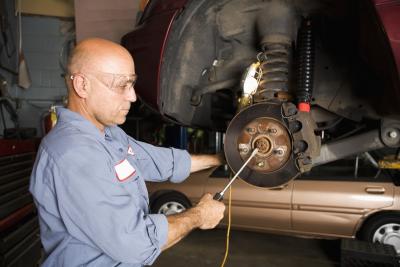
The automotive brake system is designed to decrease the speed of a fast-moving vehicle. Most of today's cars have hydraulic brake systems, which consist of disk brakes in the front and either disk or drum brakes at the rear wheels. A system of tubes and hoses link the brake at each wheel to the master cylinder. Parking brakes, power brake boosters and antilock-systems are other brake systems incorporated in most vehicles today.
The single-circuit hydraulic system consists of a system of plungers, reservoirs and hydraulic fluid. Three basic components of the single-circuit hydraulic system are the master cylinder, slave cylinder and the reservoir, which are joined together with hydraulic hose and filled with non-compressible hydraulic fluid, i.e., brake fluid. When you step on the brakes, you actually compress a small piston assembly in the master cylinder. As brake fluid does not compress, the pressure is instantly transferred to the slave cylinder where it travels through another piston assembly to activate the brakes. Heat from the brakes is transferred back into the brake fluid.
Dual-circuit hydraulic systems are usually incorporated on high-end luxury vehicles and newer motorcycles, in particular BMW bikes. The dual-circuit system consists of two separate circuits: the command circuit, which activates when you press the brakes, and a separate circuit which is controlled by an onboard computer. The first circuit sends a signal to the computer as soon as you press the brake. The computer then calculates the applied force, and applies the same force to a hydraulic pump system to activate the brakes. The computer however also calculates the car speed and other factors to determine the optimal brake pressure to help you maintain control over the vehicle.
Brake-by-wire is an advanced electronic braking system. It is very similar to the dual-circuit hydraulic system, but instead of a hydraulic command circuit, this system uses electronic wires to communicate with the computer. The brake pedal is connected to a device that measures the electrical resistance and sends an electrical signal to the brake computer. From there on, it functions exactly like the dual-circuit hydraulic system. Most brake-by-wire systems have some built-in resistance to combat any driver complaints of “lack of feel.”
Many modern cars have an antilock braking system consisting of an electronic control unit, a hydraulic actuator and wheel speed sensors at each wheel. When you slam on the brakes in an emergency stop, the wheels will lock up if there is no antilock braking system. Locked wheels prevent you from stopping the car as quickly, and can cause you to lose all steering control, often resulting in an accidents. Antilock braking systems prevent wheels from locking by rapidly pumping the brakes as soon as it detects a wheel locking up. A computer monitors the speed of each wheel, so in most cases, only the wheel that is locked will be pumped, while the full braking pressure is still available on the other wheels.
A power brake booster system is used to amplify the available foot pressure applied to the brake pedal to help you stop even the largest vehicle. This booster uses vacuum power from the engine, which is a by-product of normal operation. Valves are used to direct air into the booster, which applies extra pressure when you brake. If the engine shuts down while you are driving, a small reserve of power boost will still be available, but after a while it will become harder to brake.
Parking brakes--also called the hand brake or emergency brake--is a system consisting of steel cables that control the rear brakes. This system is completely mechanical, bypassing the hydraulic system, making it possible to bring the vehicle to a stop even if the normal brakes fail.
Air brake systems are used in buses, trailers, trucks and semi-trailers. Many trucks use compressed air brake systems, in which a standard disc or drum brake is activated by air instead of hydraulic fluid.